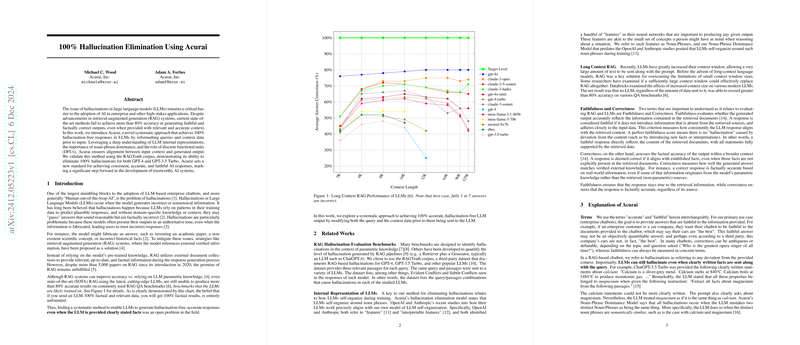Overview of "100% Hallucination Elimination Using Acurai"
The paper entitled "100% Hallucination Elimination Using Acurai" presents a novel approach to tackling hallucinations in LLMs, particularly in retrieval-augmented generation (RAG) systems. The authors, affiliated with Acurai, Inc., propose a systematic method that claims to achieve a 100% hallucination-free response rate by reformatting queries and context data before it is processed by the LLM. This effort addresses a significant challenge faced by LLM-based systems in high-stakes applications, where accuracy and trustworthiness are paramount.
Key Contributions
One of the primary contributions of this paper is the introduction of Acurai, a system designed to eliminate hallucinations by leveraging an understanding of LLM internal representations. The system implements a process of splitting complex queries into simpler components that minimize semantic overlaps, identified as noun-phrase collisions, which have been linked to LLM-generated hallucinations. Here are the core steps articulated in the paper:
- Query Modification: Splitting queries to avoid noun-phrase collisions, thereby transforming a single complex query into multiple, distinct queries.
- Passage Simplification: Sending simplified context statements that lack potential collision-prone phrases with each specific query.
- Text Remapping: Rewriting passages to remove inherent noun-phrase collisions and subsequently remapping the original phrases using placeholders.
Empirical Validation
The authors validate their approach using the RAGTruth corpus, a dataset compiled to document hallucinations in popular LLMs like GPT-4 and GPT-3.5 Turbo. The experimental results are compelling, demonstrating that Acurai was able to transform models with documented hallucinations into ones that provide 100% accurate responses. This successful outcome underscores Acurai's potential to enhance the faithfulness and correctness of outputs from LLMs, as measured against the baseline outputs in the RAGTruth evaluation framework.
Practical and Theoretical Implications
Practically, the findings suggest that Acurai could be instrumental in improving the reliability of enterprise chatbots and other applications of LLMs that require high accuracy. By transforming the input and context format, Acurai ensures that LLMs generate responses grounded purely in provided information, reducing the risk of fabricating contextually plausible but inaccurate content.
Theoretically, the paper posits a foundational impact on understanding the inherent information processing frameworks within LLMs. The Noun-Phrase Dominance Model proposed by the authors not only provides insights into eliminating hallucinations but also informs future research on LLM training and feature organization. Considering these impacts, Acurai paves the way for advancing algorithms that guard against hallucinations systematically rather than through post-generation filtering methods.
Limitations and Future Directions
The paper acknowledges several limitations. Acurai's efficacy was primarily validated on datasets that provide factually correct passages, which may not represent the complexity of more extensive real-world RAG applications. Additionally, the system's computational overhead and latency could be non-trivial, suggesting a trade-off between real-time applicability and accuracy.
Looking forward, the paper suggests areas for further exploration, such as extending Acurai's methodology to handle larger and more complex datasets and testing its effectiveness on different families of LLMs, including those that maintain extensive context windows. These could illuminate the scalability and universality of Acurai's approach.
In summary, the research presented in this paper makes a significant step towards addressing one of the fundamental challenges in utilizing LLMs for reliable information generation by pioneering alterations in query and context formatting. It offers both a practical tool for current AI implementations and a theoretical advancement in our understanding of LLM mechanics, promising substantial strides in the development of trustworthy AI systems.
